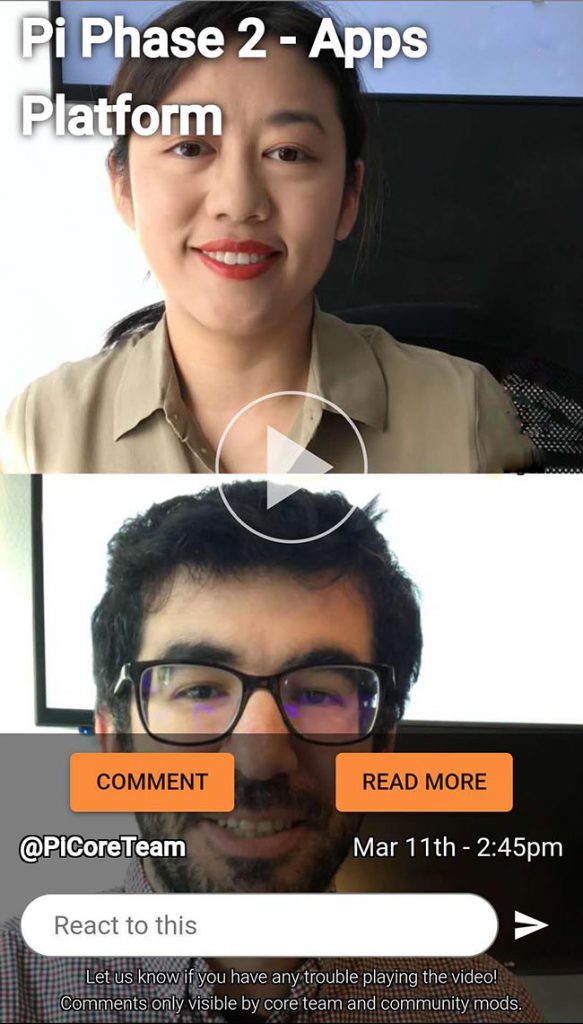Our first goal in Phase 2 is building value.As discussed in our strategy overview video, to build value, the network needs to create intrinsic utility for Pi by enabling people to spend pi to exchange for real value (versus other currencies which are only representations of real value) and products at scale, be it entertainment, social connections, influence, access, knowledge or buying and selling real goods and services for Pi.
To create a full-fledged ecosystem that mirrors the breadth and scale of traditional economies, it’s impossible to have all applications built by the core team alone. So our strategy is to decentralize the development of Pi’s ecosystem through the Pi apps platform. For example, if Pi marketplaces are necessary to facilitate and scale healthy Pi transactions, members of the community or third party developers can create Pi apps of different marketplaces that vary by region, language, and types of goods and services. While the Core Team can’t be experts in all varieties of apps, our global community and external parties can be.
Pi Core Team will focus on providing the platform to facilitate others who are more specialized in the specific domains to build those apps, such as e-commerce, logistics, supply chains, gaming, real estate or financial services. In addition to the platform, Pi Core Team will only develop a few key Pi apps that are closely tied to Pi’s vision and community building. Based on our initial research, Third-party developers of decentralized applications are very excited to tap into and contribute to Pi’s ecosystem through the platform, because Pi’s philosophy of user accessibility and the large active global community are a rare resource in the crypto space.
An Apps Platform will allow third-party developers to build applications that facilitate structured transactions using PI. The Apps Platform can include both apps that are built within Pi Network called Pi Apps as well as external applications that are able to integrate Pi into their payment options, called Pi Payments.
Pi Apps will be hosted within the Pi interfaces, for example, similar to facebook applications or WeChat mini-programs. Some categories of potential Pi Apps, that can be hosted within the Pi interface include:
Pi Financial Services Apps – Apps that allow Pioneers to access the emerging world of decentralized finance. We’ve already spoken to developers building apps to allow people to own fractional pieces of real estate as well as fractional shares in companies like Apple, Google, etc.
Pi Social Media – Apps that allow Pioneers to spend and earn Pi while engaging with high quality content. We’re especially interested in integrating Pi into Pi Network’s existing chats to curate higher-quality conversation.
Pi Marketplaces – Apps that allow Pioneers to exchange goods and services. Similar to Amazon and TaoBao for goods; and Upwork, AirBnB, and Uber for services.
Pi Games – Apps that allow Pioneers to spend Pi to play fun and engaging games similar to how gamers spend traditional currency in their games.
Pi Payments will allow external applications to integrate Pi into their payment options. Some Examples of Pi Payments include:
A QR code system that allows local retailers to accept payment in Pi
Your favorite local website creates a new “Pay with Pi” button
Someday, Amazon.com could also create a new “Pay with Pi” button on its website.
We will start with a focus on applications that are built directly on Pi Network – Pi Apps. Only when we construct a robust viable Pi ecosystem through Pi Apps, can we attract external traditional industries to integrate Pi Payments into their platforms.
We will work alongside the community to identify the most promising applications to be listed on the platform. To avoid a wild-west situation where unchecked individuals try to take advantage of fellow Pioneers, the selection of apps will involve community vetting and peer reviews to try to achieve relevance, quality and trustworthiness.
The development of the Apps platform will begin in the second quarter (Q2) of 2020. The application process for third-party developers is expected to open by the end of Q2 2020. The in-app transfer pilot proved the need for an apps platform that allows safe and efficient transactions using Pi and reduces abuses. The findings of the pilot mean that we will have to slow down enrollment into the in-app transfer pilot until more apps are added to the apps platform that scale transactions of real goods and services and we design safeguards needed to prevent further abuses.
While we will be slowing down enrollment in the in-app transfer pilot, we will expand KYC after Pi Day, as KYC will still be necessary to participate in other Pi programs. Being KYC’d will no longer automatically enable in-app transfers, but will increase Pioneers’ probability of being selected for the in-app transfer pilot lateras more applications are added to the platform. Being KYC’d will also be required for eligibility to run certain versions of Nodes on Pi’s testnet . We’ll present an update on the node in our next video and why it’s important for Pi.
翻译:Pi 阶段 2 – Pi 应用程序平台
我们第 2 阶段的第一个目标是建立价值。如我们的战略概述视频所述,为了建立价值,网络需要通过让人们使用 pi 来交换实际价值(相对于仅表示实际价值的其他货币)和规模产品,从而为 Pi 创造内在效用。它娱乐,社会关系,影响力,访问,知识或购买和销售真正的商品和服务的 Pi。
为了创建一个能够反映传统经济广度和规模的成熟生态系统,不可能由核心团队单独构建所有应用程序。因此,我们的战略是通过 Pi 应用平台分散 Pi 生态系统的开发。例如,如果 Pi 市场对于促进和扩展健康的 Pi 交易是必要的,则社区成员或第三方开发人员可以创建不同市场的 Pi 应用,这些市场因区域、语言和商品和服务类型而异。虽然核心团队不能是所有应用领域的专家,但我们的全球社区和外部方都可以。
Pi Core 团队将重点提供平台,以方便那些更专注于特定领域的其他应用来构建这些应用程序,例如电子商务、物流、供应链、游戏、房地产或金融服务。除了该平台之外,Pi Core 团队还将开发一些与 Pi 的愿景和社区建设密切相关的关键 Pi 应用程序。根据我们的初步研究,分散应用程序的第三方开发人员非常兴奋地通过平台挖掘 Pi 的生态系统并做出贡献,因为 Pi 的用户可访问性理念和大型活跃全球社区是罕见的加密空间中的资源。
应用平台将允许第三方开发人员构建应用程序,从而使用 PI 促进结构化交易。应用平台可以包括 Pi 网络中构建的称为 Pi Apps 的应用,以及能够将 Pi 集成到其支付选项(称为 Pi 付款)的外部应用程序。
Pi 应用程序将托管在 Pi 界面中,例如,类似于 facebook 应用程序或微信迷你程序。可以在 Pi 界面中托管的某些潜在 Pi 应用类别包括:
Pi 金融服务应用 – 允许先锋访问新兴分散金融世界的应用程序。我们已经与开发者进行了沟通,他们构建应用程序,让人们拥有部分房地产,以及苹果、谷歌等公司的小部分股份。
Pi 社交媒体 – 应用程序,允许先锋在参与高质量内容的同时消费和赚取 Pi。我们特别感兴趣的是将 Pi 集成到 Pi Network 的现有聊天中,以策划更高质量的对话。
Pi 市场 – 允许先锋交换商品和服务的应用程序。类似于亚马逊和淘宝商品;和上工,AirBnB 和优步的服务。
Pi 游戏 – 应用程序,允许先锋花 Pi 玩 乐趣和引人入胜的游戏类似于游戏玩家如何花费传统货币在他们的游戏。
Pi 付款将允许外部应用程序将 Pi 集成到其付款选项中。Pi 付款的一些示例包括:
允许本地零售商接受 Pi 付款的 QR 码系统
您最喜爱的本地网站创建一个新的”使用 Pi 付款”按钮
有一天,Amazon.com 也可以在其网站上创建一个新的”使用 Pi 支付”按钮。
我们将从专注于直接构建在 Pi 网络 – Pi 应用上的应用程序开始。只有通过 Pi Apps 构建一个强大的可行 Pi 生态系统,我们才能吸引外部传统产业将 Pi 支付集成到其平台中。
我们将与社区合作,确定平台上最有前途的应用程序。为了避免一种狂野的西方情况,即未经检查的个人试图利用其他先锋队,选择应用程序将涉及社区审查和同行审查,以试图实现相关性、质量和可信度。
应用平台的开发将于 2020 年第二季度 (第 2 季度)开始。面向第三方开发人员的应用程序过程预计将在 2020 年第 2 季度末打开。应用内转移试点证明,需要一个应用平台,允许使用 Pi 进行安全高效的交易,并减少滥用。试点的结果意味着,我们必须放慢应用内转移试点的注册速度,直到将更多的应用程序添加到应用平台,以扩展真实商品和服务的交易,我们设计所需的保障措施,以防止进一步的滥用。
虽然我们将放缓应用内转移试点的注册速度,但我们将在 Pi 日之后扩展 KYC,因为 KYC 仍有必要参加其他 Pi 计划。作为 KYC’d 将不再自动启用应用内传输,但会增加先锋在以后选择应用内传输试点的概率,因为更多的应用程序被添加到平台。作为 KYC’d 也将被要求资格运行某些版本的节点在 Pi 的测试网。我们将在下一个视频中介绍节点的更新,以及为什么它对于 Pi 很重要。
简评:今日消息含金量太多,稍晚 CPB 联盟将会同步翻译视频并在四百多个微信群组发布传播和解读,敬请期待。
更多详情解读请点击下方二维码扫码加入 CPB 精英群。
目前在 chinapi 币社群有数十万名 pi 币爱好者,更有资深的币圈巨鲸坐镇,我们教你如何更加迅速的赚到人生的一桶金。








